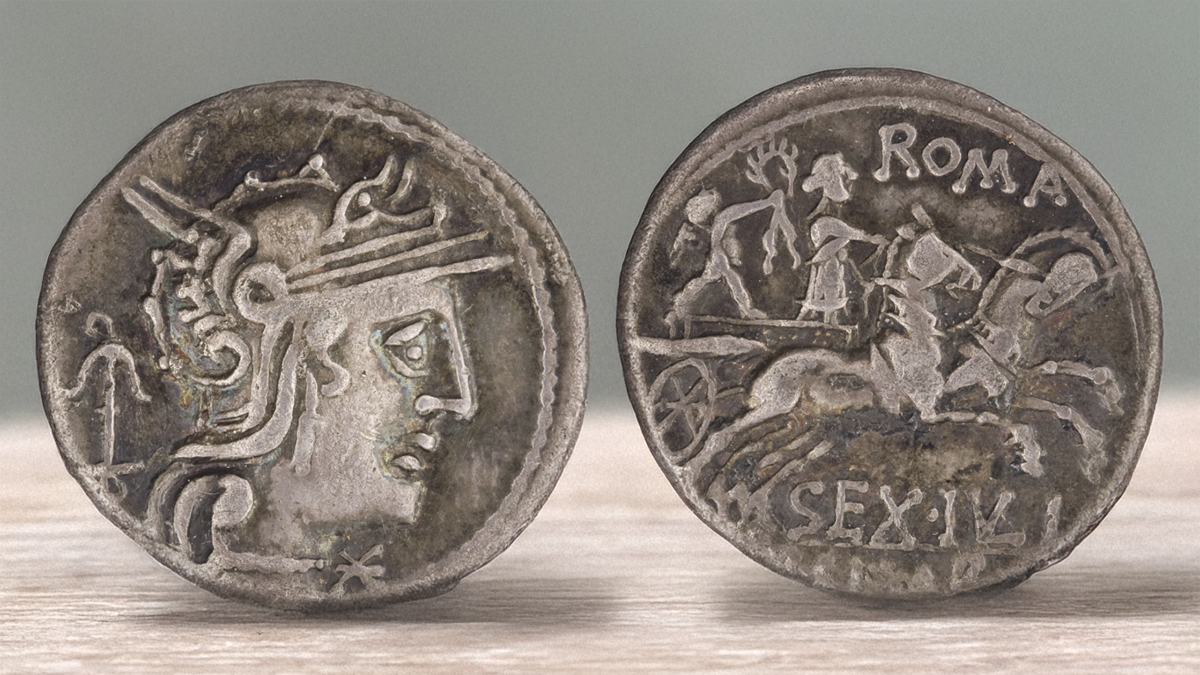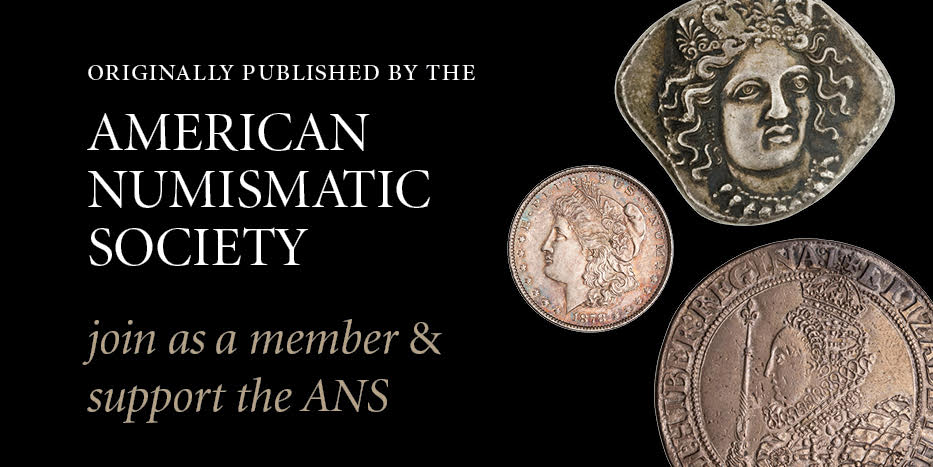By Alice Sharpless for American Numismatic Society (ANS) ……
In the Roman world, Venus was the goddess of love, beauty, and fertility. Venus and her son Cupid are common motifs on Roman coinage. However, she can only be securely identified on Roman republican coinage starting in the later second century BCE. Rather than being a symbol of love or fertility, her significance on republican coinage is usually an expression of a personal relationship between the deity and a specific family, and most of the depictions are closely tied to ideas of victory and triumph.


The earliest depictions of Venus on Roman coins are tied to only two families, the Julii and the Memmii. Both families claimed descent from the Trojans. The Julii, in fact, claimed direct descent from Venus herself through her son Aeneas, whom she rescued from Troy. The Memmii claimed Trojan descent through Mnestheus (Vergil, Aen. 5.117), one of Aeneas’ companions. In 129 BCE, Sextus Julius Caesar minted a denarius which features Venus driving a biga and being crowned from behind by her son Cupid (Fig. 1). The motif recalls triumphal imagery where the triumphator rides in a chariot while being crowned by Victory. Triumphal imagery was adapted to various deities on Roman Republican coinage, such as on RRC 223/1 where the goddess Juno is seen as triumphator crowned by Victory. Venus again appears on a denarius of the Julii in 103 BCE, this time issued by Lucius Julius Caesar (cos. 90). Venus is similarly shown driving a biga but, in a more playful take on the triumphal chariot, it is pulled by flying Cupids rather than horses (Fig. 2). A lyre, placed below the Cupids, represents Apollo, another deity closely tied to the gens Julia.

Venus is most famously utilized by the Julian family under Julius Caesar. In 48 BCE, before his defeat of Pompey at Pharsalus, Caesar vowed a temple to Venus Victrix (“Venus the Victor”) if he should win the battle (notably, Pompey had built his own temple to Venus Victrix a few years earlier). Caesar ended up instead dedicating the temple–which formed part of his new forum–to Venus Genetrix (“Venus the Mother”) as the ancestor of his own family. The divine lineage of the Julian family is particularly highlighted on a denarius of Caesar issued in 47-46 BCE (Fig. 3). The obverse features a head of Venus wearing her typical diadem, while the reverse shows her son Aeneas fleeing Troy carrying his father on his shoulder and the Palladium (the Trojan cult image of Athena) in his right hand. Caesar’s name is featured prominently on the reverse beside his famous ancestors. The issue was produced in the same years that Caesar’s temple to Venus Genetrix (dedicated 46 BCE) was being completed.



The Memmius family, though ultimately less prominent than the Julii, used similar images of Venus in triumph on their own coins. In 106 BCE, Lucius Memmius issued a denarius serratus that featured a similar reverse to Sextus Julius’ denarius (Fig. 4). Venus appears driving a biga, while Cupid again replaces Victory but this time flying above (for Victory in a similar position cf. RRC 270/1). On his bronze issues, L. Memmius adapted the traditional prow reverse to feature Venus’ head on the prow stem, while Cupid, balancing on the rostrum, reaches up to crown the image of his mother (Fig. 5). In 87 BCE, Lucius and Caius Memmius–presumably the sons of the aforementioned Lucius–adopted the same denarius types as their father (Fig. 6).


Beginning in the 80s BCE, Venus became a more prominent figure on Roman Republican coins, though still usually with connotations of victory and triumph. She also remained a figure closely tied to certain families. Lucius Cornelius Sulla displayed Venus prominently in his coinage as his patron deity. Sulla even styled himself ‘Epaphroditus’ in Greek, meaning ‘favored by Aphrodite,’ Venus’ Greek equivalent. Around 84-83 BCE, Sulla minted an aureus and denarius that show a head of Venus on the obverse, with Cupid standing beside her holding a palm branch – a typical symbol of victory (Fig. 7). The reverse shows a jug and lituus (symbols of the augur), flanked by two trophies, probably representing Sulla’s two trophies at Chaironeia, or his victories at Chaironeia and Orchomenos. Plutarch reports that Sulla even dedicated his trophies at Chaironeia to Venus, along with Mars and Victory (Plut. Sull. 19.5).
In fact, like the Julii and Memmii, Sulla’s relationship with Venus seems to be one that was passed through his family. In what may be the earliest representation of Venus on Roman coinage, Publius Cornelius Sulla, L. Sulla’s grandfather or perhaps great uncle, issued bronzes in 151 BCE with a woman’s head on the prow stem (Fig. 8). Based on the parallel with L. Memmius’ later bronzes, where the woman’s identity is made clear by the presence of Cupid (Fig. 5), as well as L. Sulla’s relationship with the deity, it makes sense to interpret the figurehead as Venus.

Although Venus appears more frequently in coinage following Sulla, there is only one issue before 82 BCE that is not issued by a member of the gens Julia, Memmia, or Cornelia, namely a denarius of Caius Norbanus from 83 BCE (Fig. 9). It shows a diademed head of Venus on the obverse of the coin and an ear of grain, fasces, and caduceus on the reverse. The exact identity of C. Norbanus is not known, and there is no particular evidence of a special familial relationship with Venus. Michael Crawford identified him as the son of the consul of 83 BCE of the same name, and himself as praetor in 43 and consul in 38 BCE. This is possible, though it would mean a rather long gap in his career, which Crawford attributes to the proscription of his father by Sulla.
Alternatively, the moneyer and the consul of 83 may be one and the same. Although he does not explicitly identify himself as consul on the coinage, the fasces–signs of imperium granted only to specific offices–may be intended to serve as a symbol of his consulship. If correct, this would mean that the moneyer was a supporter of Sulla’s rival Marius; Norbanus fought against Sulla in 83, and was later proscribed. Norbanus’ denarius would have been issued shortly after Sulla’s IMPER ITERVM issue (Fig. 6), and just as Sulla was returning to Italy. Given that Sulla attributed his victories in the east in part to his favor by Venus, the use of Venus on the coins of his rival faction appears to be in direct response to Sulla. By combining Venus with traditional symbols of Rome’s abundance (grain), imperium (fasces), and felicitas (caduceus), Norbanus’ coinage emphasizes Venus’ identity as a civic deity of Rome. While Sulla’s coins express military victory and personal divine favor, Norbanus’ instead convey the power of the state through symbols of imperium and prosperity.
* * *
* * *



